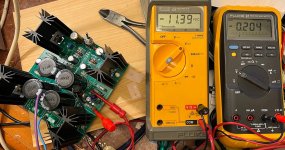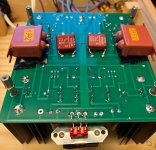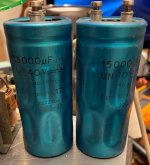Thank you for the great filter. I’m using it for a number of other things as well.
Quick feedback about the coils, as asked by Claude.
Sorry Claude, the whole thing being a work in progress during these last weeks, I didn't have the opportunity to do a dedicated comparison w/wo coil.
However, my choice to keep only the coils comes from the tests I did months ago. It was with a ‘stock’ ACA mini, and I compared ‘nothing’ vs. PO89ZB vs. Murata. This is what I noted then:
PO89ZB : the filter disembodys the musical message by a little, it takes away a little of the substance, smooths a bit too much. It’s not obvious, but noticeable. And ultimately musically not very interesting (BTW, this is the first time I feel a regression with this filter, great on any other application where I've used it)
Murata : IMHO, this is the reference point, this is what is needed. Remove it, and the message appears a little dirty, the micro details are less rendered - or distorted, the panorama is flatter, arid. The Murata adds that little extra to the contour, textures (especially in the bass), precision and attenuation of sounds, spatialization of the scene.
PO89ZB + Murata (in that order) = Murata. I didn't feel any benefit in adding the PO89ZB before the Murata.
This, according to my ears, of course.
(Thanks to Mark Johnson and Claude who actually allowed me to do such tests.)
Gilles.
Sorry Claude, the whole thing being a work in progress during these last weeks, I didn't have the opportunity to do a dedicated comparison w/wo coil.
However, my choice to keep only the coils comes from the tests I did months ago. It was with a ‘stock’ ACA mini, and I compared ‘nothing’ vs. PO89ZB vs. Murata. This is what I noted then:
PO89ZB : the filter disembodys the musical message by a little, it takes away a little of the substance, smooths a bit too much. It’s not obvious, but noticeable. And ultimately musically not very interesting (BTW, this is the first time I feel a regression with this filter, great on any other application where I've used it)
Murata : IMHO, this is the reference point, this is what is needed. Remove it, and the message appears a little dirty, the micro details are less rendered - or distorted, the panorama is flatter, arid. The Murata adds that little extra to the contour, textures (especially in the bass), precision and attenuation of sounds, spatialization of the scene.
PO89ZB + Murata (in that order) = Murata. I didn't feel any benefit in adding the PO89ZB before the Murata.
This, according to my ears, of course.
(Thanks to Mark Johnson and Claude who actually allowed me to do such tests.)
Gilles.
@xhitespirit What a great looking and creative case arrangement! Thanks to you and the others here for all the ideas and leads given.
@Mark Johnson I may be geting back to you about some of those goodies you have.
@Mark Johnson I may be geting back to you about some of those goodies you have.
Finished my amp and left channel biased right up. But for right channel i'm fully CW on P1, and getting only about 0.2V on VB, 11.5 on V0. I've read somewhere it can help to solder a 1K resistor in series with the trimmer, to extend its range.
Attachments
Last edited:
In the end i got both channel biased. Patience was the key.
Frankly, i'm a bit embarrassed. I used it like that for several evenings, while i was biasing it and seeing how it reacted to different temps in the room. I thought it sounded OK, but maybe not that special. Once i got q2 rotated i also switched power supplies, as the lab supply i had been using conked out. Using a Mean Well plus Murata now, i do think it improved things quite a bit. Imaging is very good and there is a certain spookiness to the sound.
Still on stock caps and no bypass on the big output cap, will try to remedy that situation soon.
Overall a great little circuit, well-behaved. Makes me want to try to build a variant of F5m now.
Still on stock caps and no bypass on the big output cap, will try to remedy that situation soon.
Overall a great little circuit, well-behaved. Makes me want to try to build a variant of F5m now.

Thread split on experimenting with the ACA Mini design are now here:
Experimenting with the ACA Mini circuit
I've been pondering it. Hoping to find a nixie bar graph VU build. Only really found some older sites that aren't maintained anymore so far.Has anyone added VU meters to this build? Something like THIS would work right?
Wondering if I should put it between the ACA+ and the mini. Or should I divide up the signal to input into the VU rather than putting it through? I'm new enough at this that I'm not sure what I should and should not introduce into the audio circuit or if I'm worrying about it too much.
I also ended up getting a loki mini to put between the two. It's a light enough touch as far as I can hear that it lets me fiddle with the tone without messing with the character of the amp too much. There's a build here but it only lets you mess with the bass and I wanted a tad more fiddle room. I just hope I haven't broken some kind of amp law or something.... (Gah! Don't hurt me!🤣)
Meters like these simply connect 'across' the signal, the signal does not go 'through' the circuit. In other words it goes across the speaker output for your application.
I can't see the sensitivity shown anywhere (such as needing 1 volt signal for full scale etc) but that's not an issue as you simply use a resistive divider (or preset pot) to cut the signal down as needed to suit.
An ACA or ACA mini PSU should be able to run something like this but the exact details would be up to you to figure out. The board looks to have a voltage regulator on board which may be OK for 24 volt input (check cap voltage ratings on the input side). You could add a 7812 regulator before the board if needed. Those two big resistors would need altering if you did use 24 volt input as they feed the illumination.
So I would say all very easy do-able but you have to look at the details and not just blindly connect it up.
I can't see the sensitivity shown anywhere (such as needing 1 volt signal for full scale etc) but that's not an issue as you simply use a resistive divider (or preset pot) to cut the signal down as needed to suit.
An ACA or ACA mini PSU should be able to run something like this but the exact details would be up to you to figure out. The board looks to have a voltage regulator on board which may be OK for 24 volt input (check cap voltage ratings on the input side). You could add a 7812 regulator before the board if needed. Those two big resistors would need altering if you did use 24 volt input as they feed the illumination.
So I would say all very easy do-able but you have to look at the details and not just blindly connect it up.
Well, the board I'm looking at should probably be on its own power supply anyway....
https://www.ebay.com/itm/224270222385
That said, I guess I feel a tad bit more comfortable about this now.
https://www.ebay.com/itm/224270222385
That said, I guess I feel a tad bit more comfortable about this now.
From a purist point of view the NIXIE one is the one that could cause audio degradation because it uses an unshielded step up switching power supply. That inductor and also wiring will radiate lots of energy (high frequency noise and hash). That is the downside to that one.
Is it simply a matter of putting it in its own chassis and running a separate output to it, or would you consider it a lost cause?
If you guys think i should make my own thread, please say so and i will. Until then i will keep posting about my little ACA Mini that's now a week or so old. I swapped out the stock C1 for some Soviet caps i had lying around, and scavenged a couple 2.2uF caps to use as C2 bypasses from an old amp. I checked that they weren't shorted and in they went. I thought this was the biggest improvement yet. There wasn't quite enough room under the board for the caps, so i put some extra risers on it. Mini on stilts.
The Wima caps came from an old DIY amp i bought for parts, i believe most parts inside are from the mid-70s. It also happened to have a pair of huge beer can 15.000uF caps inside. I will try reforming them and assuming they take reform well, i view them as fully flight rated. Question then becomes, if you had to use them, would you use them in the C2 or C3 position, and why? Thanks folks!
The Wima caps came from an old DIY amp i bought for parts, i believe most parts inside are from the mid-70s. It also happened to have a pair of huge beer can 15.000uF caps inside. I will try reforming them and assuming they take reform well, i view them as fully flight rated. Question then becomes, if you had to use them, would you use them in the C2 or C3 position, and why? Thanks folks!
Attachments
Is it simply a matter of putting it in its own chassis and running a separate output to it, or would you consider it a lost cause?
Only you can answer that 🙂 In its own case and away from everything else is probably OK functionally but I would want anything like this built into the amp rather than a separate box.
- Home
- Amplifiers
- Pass Labs
- DIY ACA mini



